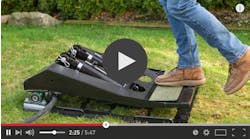Technological advances are transforming every aspect of our lives, from virtual personal assistants to autonomous vehicle features. These advancements are moving even more quickly in manufacturing environments, where technologies such as automated guided vehicles and augmented reality play significant roles in our production process.
It’s no exaggeration to say the automotive industry is experiencing more disruption now than it has in its entire history. New entrants such as Tesla and China-based Byton are challenging long-established program management processes, and mobility-as-a-service companies such as Uber and Lyft threaten the traditional vehicle ownership model. The next generation of consumers is accustomed to a digital lifestyle with smartphones, social media and connected devices, and the automotive industry needs to keep up with these digital changes.
At Faurecia, we embarked on our own digital transformation journey to implement the latest Industry 4.0 solutions. As the world’s sixth-largest automotive parts supplier, we manufacture interiors, seating, electronics and clean mobility technologies and must adapt to changing industry advancements to ensure our long-term growth.
As part of this journey, we have successfully digitized many of our KPIs and procedures, but one area remained in an analog world: frontline employee communications.
This gap sent us looking for a digital solution to connect frontline employees and provide a streamlined platform for sharing ideas. We needed it to complement our preexisting tools while adding to our digital transformation roadmap.
Since our factories are standardized around the world, exchanging and leveraging improvement ideas should be straightforward. However, our current idea exchange still relied on handwritten submissions and minimal digital involvement. We did not have an easy way to search for common ideas or communicate ideas between facilities, leaving many solutions and potential cost savings underrealized.
We ultimately settled on a solution called Rever. In March, we started a proof of concept phase with the software at our Saline, Michigan, facility, and have recently expanded it to our Blue Springs, Missouri facility. In our Saline facility, approximately 100 employees utilize the app, which includes a mix of salaried workforce, Production, Control and Logistics, and other frontline positions. In the six months since we launched, 75 ideas have been submitted and 28 ideas implemented, resulting in $61,000 worth of cost savings such as streamlining production lines and recycling materials opposed to purchasing brand new.
Additionally, Rever can facilitate internal competitions to motivate users to submit ideas and provides options for employee recognition, such as star ratings and positive comment functionality, which helps increase engagement between frontline employees and managers.
We are still early in the proof-of-concept phase, but so far, the results are encouraging and highlight the importance of a connected workforce. As a global company, it is important ideas are communicated quickly and readily implemented to support our program launches around the world.
As an example: The Ford Focus launched in three countries: France, Thailand and the United States. Our facilities in these regions each faced similar challenges, meaning a common tool for exchanging ideas would benefit our global teams.
Implementing a digital tool in a manufacturing environment is challenging and there are inevitable growing pains. Per our health and safety regulations, press operators, who do deal with customers on occasion and need to stay up to date on company news and operations, are not allowed to use their phones on the plant floor, meaning they can only access the app during break times or after work. Additionally, in facilities with an older workforce, employees may not have smartphones to download the app.
Neither challenge is insurmountable, but both are worth considering as you explore digital communications solutions. One solution we implemented was the installation of community tablets in break areas. This encourages access to the app in a safe area and provides employees without a smartphone an opportunity to utilize the tool.
Our digital transformation journey is far from complete, and we must remain open to new technologies. Despite all the advancements, human data remains just as important as process data. Leveraging best practices and diverse ideas from our 120,000-plus global workforce is essential, which is why Faurecia is passionate about digital employee engagement.
Technological advancements will never slow down, but it is important industries do not lose site of the human connection. Human-generated ideas and best practices remain our best source of innovation and the best way to realize these ideas is through a connected workforce.










